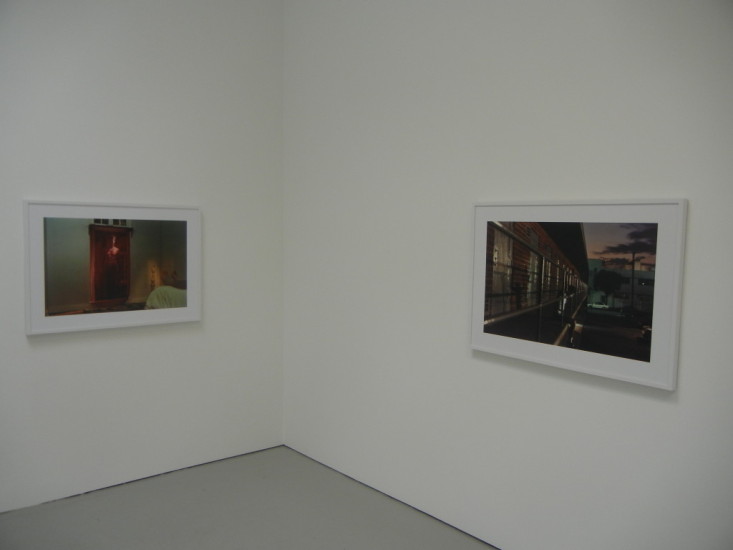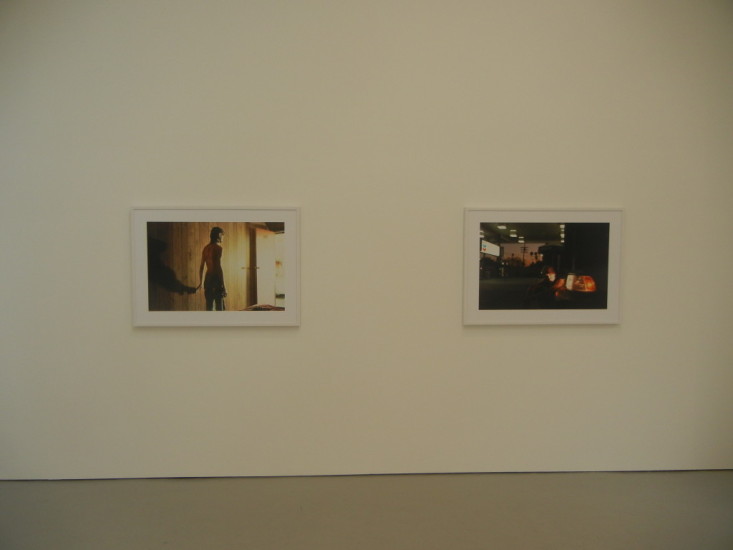JTF (just the facts): A total of 36 color photographs, framed in white and unmatted, and hung against white walls in the front gallery of the 533 space, the front and back galleries of the 525 space, and the transitional gallery between the two. All of the works are chromogenic prints, made between 1990 and 1992; each print is sized roughly 24×36 and is available in an edition of 20+2AP. A three channel silent video runs in the back gallery of the 533 space, 6 minutes 36 seconds long, from 2012. A monograph of this body of work was recently published by Steidldangin (here). (Installation shots below, in a slideshow.)
Comments/Context: This exhibit of Philip-Lorca diCorcia’s well known hustler series from the early 1990s is built using one of my favorite curatorial mechanisms: the extended replay. In its simplest form, this approach takes a body of work that has already stood the test of time (and that we as viewers are already quite familiar with) and deepens our understanding of it by showing us a larger sample, often in the form of lesser known images, outtakes, contact sheets, or other related ephemera. This particular show takes a large sample of popular choices from diCorcia’s Hollywood series and intermingles them with a dozen images from the same project that weren’t included in the original 1993 MoMA show. It’s like going to a family reunion and seeing both your favorite loved ones and a bunch of distant cousins who you don’t really know, but who are clearly related to everyone else.
Twenty years later, it’s a little bit hard to try and put ourselves back into the mindset of the early 1990s, when coming on the heels of the AIDS epidemic and the furor over Mapplethorpe’s photographs, diCorcia’s paying of his Santa Monica Boulevard drifters, addicts, and male prostitutes with his NEA grant money was more obviously a thumb in the eye of the establishment. What is much easier to see, especially given all the staging we have seen in contemporary photography over the past two decades, is just how innovative diCorcia was in planning out his cinematic scenes. Having left the confines of home and studio and having moved out into the uncertainty of the streets, his control of the settings, particularly the lighting, is nothing short of remarkable. He employs the ambient glow of signage (Ralph under the Del Taco sign and Ike in the Mayfair supermarket parking lot), the harsh glare of an up close flash (cross dressing Marilyn and Sparky in the cinder block back yard), the soft diffused light of sunset (Todd in the back of a car and Mike staring at the bank of pay phones), and the yellow tint of motel rooms (Roy in his pointy white shoes and backlit Gerald) with equal theatrical flair. Lesser known images push his dramatic lighting techniques into additional open ended situations: crouching Keith blasted by a gas station headlight, Rance and Rose warmed by a bus stop lightbox, Brian lit from above like an angel, and an unknown man silhouetted against the seedy entrance of a motel. Other pictures center on scene stealing props and visual hooks, opening up more potential narratives: a crashed car, a Christmas tree lot, chain link fence at a scenic overlook, a McDonald’s drive thru, a game of hide and seek in an empty garage, and of course, the famous diner burger. Seen together, I found many of the unknown images to be just as powerful and well crafted as the rightfully iconic ones, and with more examples on view, it was easier to see the patterns in what diCorica was constructing.
I think the enduring frission in these pictures come from their unapologetic mix of fact and fiction; we know the images have been meticulously staged, and yet, the photographs are plausibly real, making us want to believe. Unlike many who have followed in his footsteps, diCorcia’s works find the right balance, pushing and pulling us back and forth, seducing us with what looks like documentation, without losing us to obvious falsehood. That the colors are so lush and the stories so quietly sad makes the images even more robustly three dimensional; each one offers us the opportunity to dive in and create a tale of our own choosing. Resist the notion that you’ve seen these great photographs before and already know what they have to say; the broader selection of works on view here makes diCorcia’s hustlers even richer than you might remember.
Collector’s POV: The prints in this show are priced in ratcheting editions, starting at $30000 and rising to $60000, with several images sold out. DiCorcia’s work is widely available at auction, with recent secondary market prices ranging between $5000 and $72000, with a sweet spot between $10000 and $25000.

















